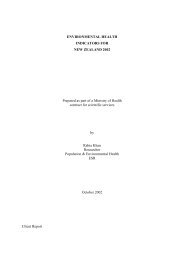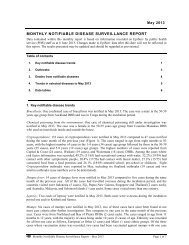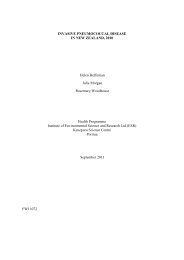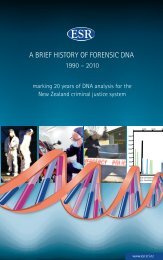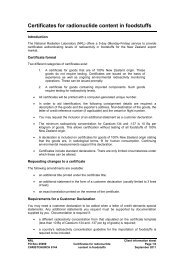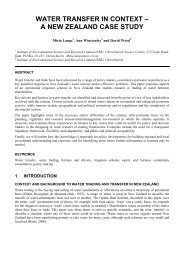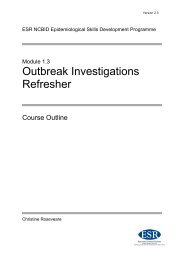Biocontrol of foodborne Bacteria: Past, Present and future strategies
Biocontrol of foodborne Bacteria: Past, Present and future strategies
Biocontrol of foodborne Bacteria: Past, Present and future strategies
You also want an ePaper? Increase the reach of your titles
YUMPU automatically turns print PDFs into web optimized ePapers that Google loves.
Scientific Review ArticleSCIENTIFIC SUPPLEMENT AUGUST/SEPTEMBER 2007<strong>Biocontrol</strong> <strong>of</strong> Foodborne<strong>Bacteria</strong>: <strong>Past</strong>, <strong>Present</strong><strong>and</strong> Future StrategiesMcIntyre, L. 1Hudson, J.A. 1 ,Billington, C. 1Withers, H. 21 Institute <strong>of</strong> Environmental Science <strong>and</strong> Research Ltd., POBox 29 181, Christchurch 85402 AgResearch MIRINZ, Ruakura Research Centre,Private Bag 3123, HamiltonIntroductionConsumers dislike the use <strong>of</strong> chemical preservatives in theirfood, <strong>and</strong> with some there is an associated public health risk.This has increased the pressure for these chemicals to be removedfrom food <strong>and</strong> for the adoption <strong>of</strong> more ‘natural’ means<strong>of</strong> preservation. While there is a variety <strong>of</strong> approaches to usingnatural preservatives, the most <strong>of</strong>ten adopted approach to datehas been to use biocontrol.The Parliamentary Commissioner for the Environment definesbiocontrol as ‘Using biological means (such as parasites,viruses or predators) to control a pest’ (http://www.pce.govt.nz/reports/pce_reports_glossary.shtml). For the purposes <strong>of</strong>this review the pest is primarily the pathogen <strong>of</strong> concern in aparticular food, but biocontrol can also be applied to spoilageorganisms <strong>and</strong> some examples <strong>of</strong> this will be given.Potential c<strong>and</strong>idates for biocontrol in foods include bacteriophages,bacteriocins (peptides secreted by one species thatinhibit another), siderophores (molecules that sequester iron),quorum sensing (where the presence <strong>of</strong> an autoinducer <strong>of</strong> onespecies may influence the growth <strong>of</strong> another), competitive organisms,<strong>and</strong> various microbe- <strong>and</strong> plant-derived antimicrobials.Of these, siderophores might be considered as a c<strong>and</strong>idatebiocontrol mechanism for lower iron foods such as seafood(Gram <strong>and</strong> Melchiorsen, 1996) <strong>and</strong> produce (Henry et al., 1991)but they are not discussed further here.What follows is a review <strong>of</strong> current <strong>and</strong> potential food-relatedapplications <strong>of</strong> selected biocontrol approaches.Viral predators – bacteriophagesBacteriophages (phages) are viruses that exclusively infect<strong>and</strong> kill bacteria. Their structure is simple, comprising nucleicacid contained within a protein capsule that may include a lipidcomponent. When a phage <strong>and</strong> a host meet (step 1, Figure 1)there needs to be a match between structures on both, <strong>and</strong> thisconfers specificity on the interaction, i.e. any given phage willonly infect a specific group <strong>of</strong> hosts. During infection nucleicacid is passed from the phage into the host through its cell wall(step 2). In the case <strong>of</strong> lytic phages, which kill their host soonafter infection, their nucleic acid is expressed to produce proteinswhich hijack the cell, forcing it to replicate phage nucleicAugust/September 200725
acid (step 3) <strong>and</strong> produce new phages (step 4). When, typically,around 100 new particles have been made, they are releasedfrom the host cell by fatal disruption <strong>of</strong> the cell wall (lysis, step5), <strong>and</strong> each progeny virus can then infect another cell.5Figure 1: The lytic cycle <strong>of</strong> bacteriophage infection (notto scale)The potential for using phages to kill bacteria has been recognisedfor almost 100 years, with early pioneering work beingcarried out at around the time <strong>of</strong> the First World War. However,phage therapy for human disease was not adopted in Westerncountries <strong>and</strong> the discovery <strong>of</strong> antibiotics saw an end tothe early era <strong>of</strong> phage therapeutics, apart from in the SovietUnion <strong>and</strong> Eastern Europe. More recently, there has been arenaissance <strong>of</strong> interest in phage therapy for human <strong>and</strong> animalclinical applications stimulated by the emergence <strong>of</strong> antibioticresistantbacteria.Phage biocontrol <strong>of</strong> <strong>foodborne</strong> pathogens is a rather morerecent idea, which seems to be gaining momentum. Several studieshave now been published describing such uses, includingthe application <strong>of</strong> phages to control Salmonella (a Salmonellaphage is shown in Figure 2) in bean sprouts, broiler carcasses,frankfurters, chicken skin, cheese <strong>and</strong> melon; Listeria monocytogeneson melon <strong>and</strong> cheese; Campylobacter on chicken skin;<strong>and</strong> Escherichia coli O157 on beef. These have recently beenreviewed (Hudson et al., 2005). Commercial production <strong>of</strong> thefirst phage for use in foods has begun in the Netherl<strong>and</strong>s (www.ebifoodsafety.com), with their Listex P100 product (Carlton etal., 2005) launched to control Listeria in cheese <strong>and</strong> meat. Thispreparation has now received FDA approval (www.foodqualitynews.com/news/;story accessed 26 October 2006).Figure 2: Salmonella phages ready <strong>and</strong> waiting for theirnext victim1423In many food studies inactivation is only achieved by usinga high phage to host ratio (the multiplicity <strong>of</strong> infection, orMOI). In addition, inactivation has been reported to occur attemperatures beneath the growth minimum <strong>of</strong> the host. Thesefacts suggest that the inactivation reported may be due to lysisfrom without, whereby large numbers <strong>of</strong> attached phages killthe cell via the ‘death <strong>of</strong> a thous<strong>and</strong> cuts’. An example whichcould be explained by this is the inactivation <strong>of</strong> Salmonella onmelon which was reported to occur at 5°C <strong>and</strong> at an MOI <strong>of</strong>200 (Leverentz et al., 2001). However, other explanations arepossible. We have recently obtained some evidence suggestingthat lysis from without <strong>and</strong> infection can occur simultaneously<strong>and</strong> contribute to cell death.The host specificity <strong>of</strong> the phage may present a problemfor biocontrol if it is too narrow - within each pathogen speciesthere are numerous sub-types which all need to be controlled.An effective phage should therefore have a ‘Goldilocks’host range, not too narrow <strong>and</strong> not too broad. An example <strong>of</strong>a phage with an almost perfect host range is Felix O1 whichlyses 96-99.5% <strong>of</strong> Salmonella serovars (Lindberg, 1967). Workwith spoilage organisms has shown that if the host range istoo narrow biocontrol does not work (Greer <strong>and</strong> Dilts, 1990).One possibility that would overcome this limitation is to usephage cocktails, <strong>and</strong> this has proved successful for controllingEscherichia coli O157:H7 on beef (O’Flynn et al., 2004).Public perception may also be an obstacle. Would the averageconsumer respond favourably to knowing that viruses hadbeen added to their food? Maybe they would. A recent Americanarticle indicates that some people see phages as ‘green’ <strong>and</strong>environmentally friendly (Fox, 2005). Phages may also be seenas a natural alternative to chemical preservatives. Early phagetherapy pioneers demonstrated safety by ingesting preparationsthemselves, <strong>and</strong> a recent publication reported the safe intake <strong>of</strong>phage T4 by volunteers (Bruttin <strong>and</strong> Brüssow, 2005). Whateverthe perceptions concerning safety it is a fact that phages are anormal component <strong>of</strong> foods (Tsuei et al., 2007) <strong>and</strong> so are beingingested by everyone every day.The direct application <strong>of</strong> phages to foods is only one biocontrolapproach that might be adopted. For many pathogens,contamination <strong>of</strong> meat occurs either directly or indirectly fromthe animal’s faeces during processing. The use <strong>of</strong> phages todestroy pathogens within the intestinal tracts <strong>of</strong> food animalscould therefore be a way <strong>of</strong> reducing the number <strong>of</strong> pathogenson meat. While the use <strong>of</strong> phages to kill Salmonella in host gutshas historically met with mixed results, the inactivation <strong>of</strong> bothSalmonella <strong>and</strong> Campylobacter in chickens has been demonstrated(Loc Carrillo et al., 2005; Atterbury, 2007).Another approach is the application <strong>of</strong> purified phage-derivedantimicrobials. These are enzymes (endolysins) producedby lytic phages which degrade the cell wall from the inside out,allowing phages to burst out <strong>of</strong> the cell. These enzymes aregenerally very host specific (Fischetti, 2005) <strong>and</strong> can also workfrom the outside in. The use <strong>of</strong> endolysins is therefore best suitedfor Gram positive pathogens, because Gram negative hostshave an outer membrane which hinders access by the enzymeto the cell wall. However, this barrier is not insurmountable,with peptidoglycan degradation by a Pseudomonas endolysinrecently demonstrated (Paradis-Bleau et al., 2007).Phage <strong>and</strong> phage-derived technologies therefore present atoolbox <strong>of</strong> techniques using anything from intact viable phagesto enzymes derived from them, any <strong>of</strong> which could be appliedalong the farm-to-fork continuum. The trick will be to identifywhich tool is best suited to which segment <strong>of</strong> the value chain.<strong>Bacteria</strong>l predators – BdellovibrioA number <strong>of</strong> predatory bacteria are also capable <strong>of</strong> attacking<strong>and</strong> killing bacteria in a manner similar to that described26Food New Zeal<strong>and</strong>
previously for phages. The best characterised <strong>of</strong> these is theGram-negative Bdellovibrio bacteriovorus, so called because <strong>of</strong>its parasitic leech-like behaviour (latin ‘bdello’) <strong>and</strong> curved ‘vibrio’shape. First isolated from soil by Stolp <strong>and</strong> Starr in 1962,this ubiquitous organism has since been found in a variety <strong>of</strong>environments including fresh, salt <strong>and</strong> brackish waters, sewage<strong>and</strong> mammalian intestines.Current knowledge <strong>of</strong> the predatory cycle <strong>of</strong> B. bacteriovorushas recently been reviewed by Lambert et al. (2006) whodescribe a recent renaissance in research activity. This is attributed,in part, to the first description <strong>of</strong> the entire genomesequence <strong>of</strong> B. bacteriovorus strain HD100 by researchers at theMax-Plank-Institute for Developmental Biology (Rendulic et al.,2004). The replication cycle, is shown as a clock-wise series <strong>of</strong>events in Figure 3.In the ‘attack phase’, Bdellovibrio cells are small, mon<strong>of</strong>lagellated<strong>and</strong> extremely fast moving. Following a collision with aGram-negative prey cell (shown in blue; Figure 3), the attackingcell attaches to <strong>and</strong> invades prey using ‘twitching-type’ pili topull it through holes in the cell wall generated using a blend <strong>of</strong>hydrolytic enzymes. Internalisation <strong>of</strong> Bdellovibrio in the preycell’s periplasm results in loss <strong>of</strong> the flagellum <strong>and</strong> a morphologychange to produce a non-motile elongated ‘growth phase’form in a joint predator:prey structure known as a bdelloplast.Replication then occurs in the bdelloplast, followed by preylysis <strong>and</strong> escape back into the environment.Figure 3: The predatory life cycle <strong>of</strong> Bdellovibrio bacteriovorus(Snježana Rendulic, Jürgen Berger, Stephan C.Schuster, PhD/Max-Plank-Institute)http://jama.ama-assn.org/cgi/reprint/291/10/1188Given the reported absence <strong>of</strong> horizontal gene transferduring predation <strong>and</strong> an inability to invade mammalian cells,Bdellovibrio has been suggested as a ‘living antibiotic’, or atthe very least a useful source <strong>of</strong> novel antimicrobial substances(Rendulic et al., 2004; Lambert et al., 2006). With its varied environmentalniches <strong>and</strong> a relatively broad host range, it hasparticular appeal in the battle against Gram-negative pathogenssuch as Salmonella <strong>and</strong> E. coli O157 in both food <strong>and</strong> water.Unsurprisingly, given the previous lack <strong>of</strong> interest in thisorganism, there are relatively few applied research publicationsto date. Fratamico <strong>and</strong> Cooke (1996) reported the ability<strong>of</strong> Bdellovibrio isolates to control E. coli O157:H7 <strong>and</strong> Salmonellaspp. on stainless steel surfaces, suggesting the potentialfor application to food processing equipment <strong>and</strong> food. Theability <strong>of</strong> B. bacteriovorus strain 109J to attack E. coli bi<strong>of</strong>ilmswas reported some time later by Kadouri <strong>and</strong> O’Toole (2005).A 7 log 10reduction in planktonic E. coli numbers was foundafter 24 hours <strong>of</strong> exposure, while bi<strong>of</strong>ilm-associated pathogennumbers declined by 4 logs. Although cells in this bi<strong>of</strong>ilm wereclearly able to survive predation to a far greater extent, thiswork does suggest that Bdellovibrio could go some way towardsreducing the issues associated with bi<strong>of</strong>ilms in the foodindustry <strong>and</strong> in other situations.Some preliminary findings investigating food <strong>and</strong> water applications<strong>of</strong> a salt water Bdellovibrio isolate have recently beenreported by a New Zeal<strong>and</strong>-based research group (Ahmed etal., 2006). In a king salmon shelf life trial, an extension <strong>of</strong> thelag phase during growth <strong>of</strong> the total micr<strong>of</strong>lora was evident inthe presence <strong>of</strong> Bdellovibrio at a storage temperature <strong>of</strong> 20°C,but no extension was observed at 10°C. The ability <strong>of</strong> Bdellovibrioto reduce coliform levels in polluted recreational waterswas also reported, but practical scale-up could be difficult.Further research <strong>of</strong> this type is clearly necessary to determinehow whole Bdellovibrio cells or derived antimicrobialscan be successfully applied to specific situations. It is howeveranticipated that further research findings will be forthcoming inthis area as researchers continue to look for naturally occurringways to control pathogens.Competitive exclusion, protective pultures <strong>and</strong> antimicrobialmetabolitesTo date, the biocontrol approach with the greatest consumeracceptance is the use <strong>of</strong> naturally occurring antagonistic bacteria<strong>and</strong>/or their antimicrobial metabolites. These organismsuse their ability to outcompete pathogens (by outnumberingthem <strong>and</strong> creating an unfavourable environment) rather thanconducting physical attack <strong>and</strong> destroy missions. The use <strong>of</strong>competitive exclusion (CE) cultures in animals, <strong>and</strong> protectivecultures <strong>and</strong> metabolites in foods are not new concepts (Andersonet al., 2006), <strong>and</strong> great efforts have been devoted to thecharacterisation <strong>and</strong> commercialisation <strong>of</strong> bacteria <strong>and</strong> metabolitesfor such purposes.The lactic acid bacteria (LAB) have been most extensivelyinvestigated as CE <strong>and</strong> protective culture c<strong>and</strong>idates as they aremajor components <strong>of</strong> the micr<strong>of</strong>lora <strong>of</strong> both healthy mature animals<strong>and</strong> foods. They also produce antimicrobial compoundsincluding acids, hydrogen peroxide, diacetyl <strong>and</strong> bacteriocinswhich gives them an additional edge against related organismsthat might otherwise predominate in a particular environmentalniche. However, other non-pathogenic microorganisms can alsobe suitable.In all cases, regardless <strong>of</strong> the application being considered,defining these microorganisms is important to ensure that CE/protective cultures do not contain potentially pathogenic subpopulationsor virulence <strong>and</strong> antimicrobial resistance genes thatcould be transferred to either the animal or human host micr<strong>of</strong>lora(Wagner, 2006).<strong>Bacteria</strong>l antagonists <strong>of</strong>fer a number <strong>of</strong> options in terms <strong>of</strong>a farm-to-fork approach to food safety. CE cultures can be appliedpreharvest (Anderson et al., 2006) to prevent the colonisation<strong>of</strong> food animals with human pathogens such as Salmonella<strong>and</strong> Campylobacter (Chaveerach et al., 2004). Postharvest use<strong>of</strong> protective cultures <strong>and</strong>/or antimicrobials during formulation<strong>and</strong> processing adds an additional hurdle by either manipulatingthe composition <strong>of</strong> the micr<strong>of</strong>lora to the detriment <strong>of</strong> pathogens<strong>and</strong>/or introducing inhibitory substances active againstthem. These approaches will be addressed separately below.CE culturesThe application <strong>of</strong> CE cultures to enhance animal productivityhas been promoted in part by the increased use <strong>of</strong> antibiotics<strong>and</strong> the consequent development <strong>of</strong> resistance amongstAugust/September 200727
microbes (Anderson et al., 2006; Diez-Gonzalez & Schamberger2006). CE cultures may act to control or inhibit other microbesvia mechanisms including (i) nutrient competition; (ii) production<strong>of</strong> inhibitory compounds; (iii) immunostimulation; <strong>and</strong>/or(iv) competition for binding sites. Ideally, microbes used forCE applications should adhere well to epithelial cells to allowcolonisation to occur.Applications have included the inhibition <strong>of</strong> E. coli O157:H7 in cattle (Brashears et al., 2003; Stephens et al., 2007) <strong>and</strong>Salmonella, E. coli O157:H7 <strong>and</strong> Campylobacter in poultry usinga variety <strong>of</strong> microorganisms (Diez-Gonzalez & Schamberger,2006). Non-LAB organisms include ‘generic’ E. coli which caninhibit E. coli O157 through the production <strong>of</strong> colicins (Schamberger& Diez-Gonzalez 2002; 2004). Colicins have also beendescribed that inhibit other STEC serotypes such as O26 <strong>and</strong>O111 (Murinda et al., 1996).While successes have been reported, the choice <strong>of</strong> strain isan important factor (Stephens et al., 2007) along with its survivalcharacteristics, particularly under acidic conditions in thegut, <strong>and</strong> the method <strong>of</strong> administration (Anderson et al., 2006).Only one defined product known as PREEMPT has been approvedby the USFDA for poultry applications (Anderson et al.,2006) but production was halted in 2003 due to reduced carriage<strong>of</strong> Salmonella. Canadian biotech company CanBiocin currentlymarket an LAB-based product called Procin ® , developedto prevent E. coli scours in pigs.Protective cultures <strong>and</strong> antimicrobial metabolitesThe application <strong>of</strong> LAB as protective cultures to enhancefood safety has been extensively reviewed (Goktepe, 2006).Key considerations for this type <strong>of</strong> approach include the doserequired for effective antagonism in the food in question <strong>and</strong>the potential effects on sensory properties. Several species <strong>of</strong>bifidobacteria have been applied to fish, seafood, poultry <strong>and</strong>dairy foods to extend shelf life <strong>and</strong> protect against pathogens.Reported shelf life extensions range from 3 to 14 days dependingon the food <strong>and</strong> the mode <strong>of</strong> application, <strong>and</strong> can be enhancedby the combined use <strong>of</strong> acid salts such as sodium acetate<strong>and</strong> potassium sorbate (Goktepe, 2006). Similarly, lactobacillihave been exploited in a variety <strong>of</strong> food applications includingmeats, fish, vegetables <strong>and</strong> dairy products (Bredholt et al., 1999;2001; Scolaria & Vescovo, 2004; Millette et al., 2006). Their antimicrobialactivity has been attributed to the production <strong>of</strong> lacticacid <strong>and</strong> a variety <strong>of</strong> antimicrobial compounds.The elucidation <strong>of</strong> antimicrobial compounds produced bybacteria has been an area <strong>of</strong> intense research, particularly theproduction <strong>of</strong> bacteriocins, antimicrobial peptides which producespores in the cytoplasmic membrane, ultimately inhibitingenergy production <strong>and</strong> biosynthesis activities. These <strong>of</strong>fer anothermeans <strong>of</strong> control, either through the direct use <strong>of</strong> culturesknown to produce certain compounds, or via the addition <strong>of</strong>fermentates containing antimicrobials.The best known bacteriocin, nisin, is produced by Lactococcuslactis. It has an unusually broad host spectrum againstboth Gram-positive spoilage <strong>and</strong> pathogenic bacteria includingListeria monocytogenes, Bacillus <strong>and</strong> Clostridium, making it aparticularly attractive food additive for processed cheeses <strong>and</strong>canned vegetable products. Although nisin has been approvedfor use in an estimated 50 countries, it does demonstrate somelimitations in relation to food type <strong>and</strong> pH (Deegan et al., 2006).Hence, research activities have continued unabated to isolate<strong>and</strong> characterise bacteriocins produced by other bacteria.Despite these efforts, the availability <strong>of</strong> commercialised bacterialcultures <strong>and</strong> metabolite-based antimicrobial products isnot as extensive as might be anticipated. Danisco produce <strong>and</strong>market a range <strong>of</strong> protective cultures <strong>and</strong> defined <strong>and</strong> undefinedfermentates containing antimicrobial metabolites for foodapplications. Cultures <strong>and</strong> undefined fermentates are seen asmore consumer-friendly approaches not requiring extensive labelling(Deegan et al., 2006). Defined (purified) fermentates onthe other h<strong>and</strong> need to be labelled as additives.The Danisco HOLDBAC range <strong>of</strong> protective cultures canbe used in dairy <strong>and</strong> meat products (including fermented versions)to control the growth <strong>of</strong> fungal <strong>and</strong> bacterial undesirablesincluding L. monocytogenes (Delves-Broughton et al., 2007).CanBiocin also market Micocin ® , a US Department <strong>of</strong> Agriculture-approvedLAB product with activity against Listeria for usein processed meat products. Examples <strong>of</strong> defined antimicrobialsinclude powdered nisin, marketed as Nisaplin ® , <strong>and</strong> Natamax® , a broad spectrum antifungal compound produced bythe fermentation <strong>of</strong> Streptomyces natalensis. Another definedbacteriocin, ALTA 2431, produced by Pediococcus acidilactici,is commercially manufactured by Kerry Bioscience (Deegan etal., 2006).Undefined fermentates are marketed as Microgard ® fermentedmilk <strong>and</strong> sugar powders which can be labelled as ‘culturedmilk’ or ‘cultured dextrose’ (Delves-Broughton et al., 2007).These products, typically produced by fermentations using Propionibacteriumfreudenreichii or Lactococcus lactis, are multifactorialin their activity, <strong>and</strong> can be used in a range <strong>of</strong> foodsincluding dairy, salad dressings, ready-to-eat meals <strong>and</strong> bakedgoods.While the use <strong>of</strong> antagonistic bacteria <strong>and</strong>/or bacteriocinsis not a total food safety solution, they can be combined withother preservation systems, e.g. modified atmospheres (Lu etal., 2004), bioactive packaging <strong>and</strong> high pressure processing(Deegan et al., 2006) <strong>and</strong> bacteriophages (Reynolds, 2007). Researchto date suggests that they are most useful as one hurdlein combination with other preservation options, <strong>and</strong> their <strong>future</strong>success relies on a greater underst<strong>and</strong>ing <strong>of</strong> the mechanisms <strong>of</strong>action occurring in food systems.Antimicrobials <strong>of</strong> plant originWhilst the potential for antimicrobial effects from medicinalplant extracts has been appreciated for centuries, it is only relativelyrecently that plant-derived food ingredients have beenexplored for these properties. The most frequently used form<strong>of</strong> plant extract tested for antimicrobial activity in foods is theessential oils (EO). These are aromatic oily liquids, composed<strong>of</strong> up to sixty individual components that are usually isolatedby steam distillation (Burt, 2004). EO have been reported to beactive in vitro against a wide range <strong>of</strong> <strong>foodborne</strong> pathogenicorganisms including E. coli O157:H7, Salmonella, Shigella,Campylobacter, L. monocytogenes, Staphylococcus aureus, Bacilluscereus <strong>and</strong> Vibrio species. They are generally more effectiveagainst Gram-positive than Gram-negative microorganisms,<strong>and</strong> can be active against fungi. The most frequently describedgroup <strong>of</strong> inhibitory compounds are phenolic based, with aromatic<strong>and</strong> isothiocyanate-based components also isolated. Synergismbetween individual components from the same EO ispossible, as single fractions are sometimes less efficacious thanwhole extracts. Some <strong>of</strong> the compounds are the same as thoseinvolved in plant host defence against microorganisms (Holley<strong>and</strong> Patel, 2005).The mechanisms <strong>of</strong> action <strong>of</strong> the EO are not fully understoodat this time. It is known that phenolic components appearto integrate into the cytoplasmic membrane <strong>of</strong> the microorganismcausing increased proton <strong>and</strong> potassium permeability (Perez-Conesaet al., 2006). It has been suggested that a lowersensitivity <strong>of</strong> Gram-negative bacteria to EO may be due to theirrelatively impermeable outer membrane (Fisher <strong>and</strong> Phillips2006).The simplest <strong>and</strong> most reported method for delivery <strong>of</strong> EOantimicrobial activity is incorporation directly into the food, with28Food New Zeal<strong>and</strong>
up to 8 log kills reported (Fisher et al., 2007). However, the fatcomposition <strong>of</strong> foods has been shown to influence the effectiveness<strong>of</strong> EO. For example in low fat cheese, bay, clove, cinnamon<strong>and</strong> thyme essential oils at 1% reduced L. monocytogenes to lessthan 1 log 10cfu ml -1 at 4°C, but only clove oil was effective infull fat cheese. In further experiments, S. Enteritidis incubated at10°C was less affected by fat content, with thyme oil being theonly ineffective EO in full fat cheese (Smith-Palmer et al., 2001).It is thought that the hydrophobic nature <strong>of</strong> EO means that theytend to partition in fat <strong>and</strong> oil phases <strong>and</strong> decrease the effectiveconcentration in the water phase. Micellar encapsulation <strong>of</strong>EO may deliver a higher dose to the bacterial cell membranein these types <strong>of</strong> food environments (Gaysinsky et al., 2005),<strong>and</strong> this encapsulation strategy may also have potential for thedecontamination <strong>of</strong> surface adherent bi<strong>of</strong>ilms containing pathogens(Perez-Conesa et al., 2006).Direct addition <strong>of</strong> EO to food can result in reduced pathogenpopulations, but may also alter the food’s sensory characteristics.Incorporating EO into active packaging could be an alternativeway <strong>of</strong> delivering the antimicrobial action to the food withoutnegatively impacting on organoleptic properties. Whey proteinfilms containing 1-4% (w/v) <strong>of</strong> essential oils from oregano, rosemary<strong>and</strong> garlic were effective in inhibiting E. coli O157:H7, S.aureus, S. Enteritidis, <strong>and</strong> L. monocytogenes on laboratory media(Seydim <strong>and</strong> Sarikus, 2006). A trial <strong>of</strong> alginate-based ediblefilms containing essential oils <strong>of</strong> oregano, cinnamon <strong>and</strong> savoryreduced S. Typhimurium <strong>and</strong> E. coli O157:H7 growth on beefmuscle slices by 1-2 log 10cfu cm 2 over 5 days at 4°C (Oussalah etal., 2006). The incorporation <strong>of</strong> EO <strong>and</strong> their active fractions wasalso found to significantly reduce tensile strength <strong>and</strong> elasticity<strong>of</strong> alginate-apple puree edible films, but did not affect vapouror oxygen permeability (Rojas-Grau et al., 2007). EO could alsobe used in combination with modified atmosphere packaging(Valero et al., 2006).Another potential intervention point for the use <strong>of</strong> EO is inthe feed <strong>of</strong> food animals. Several polysaccharide-emulsified essentialoils were evaluated for introduction into pig diets for thepre-slaughter control <strong>of</strong> Salmonella Typhimurium DT104 withinthe gut (Si et al., 2006a; Si et al., 2006b). EO were stable at lowpH <strong>and</strong> active at similar minimum bactericidal concentrations tothat <strong>of</strong> dietary antibiotics used in swine rearing in some countries(100-300 μg ml -1 ). Carvacrol <strong>and</strong> thymol were found to havesimilar inhibitory activity to cinnamaldehyde on laboratory media;however, after mixing with pig food, only cinnamaldehyderetained some activity against Salmonella.Other plant materials with potential antimicrobial use in foodsinclude extracts from berries, tea <strong>and</strong> wood smoke. Grape skins,juice <strong>and</strong> seed extracts have been found to be highly inhibitoryto L. monocytogenes, but not to other common food pathogens(Rhodes et al., 2006). Both Gram-negative <strong>and</strong> Gram-positivepathogens were inhibited by Nordic berry extracts (Puupponen-Pimia et al., 2005), with cloudberry <strong>and</strong> raspberry the best inhibitors.Whole tea infusions <strong>and</strong> flavanoid extracts were inhibitorywhen applied to Bacillus cereus cultures (Friedman et al., 2006).Whilst there are some concerns about the carcinogenic effects <strong>of</strong>wood smoking on food, liquid wood smoke that has had suspectcompounds removed appears to retain antimicrobial activity <strong>and</strong>has been tested successfully for inhibition <strong>of</strong> Listeria on salmon<strong>and</strong> trout, <strong>and</strong> moulds on cheese (Holley <strong>and</strong> Patel, 2005).Plant extracts are promising antimicrobial agents, with activities<strong>of</strong>ten rivalling synthetic chemicals. However, a significantbarrier for the widespread adoption <strong>of</strong> essential oils or theircomponents is that at concentrations required for effective controlthe sensory quality <strong>of</strong> foods may be altered. The use <strong>of</strong> activepackaging, multi-hurdle <strong>strategies</strong> with lowered doses, orcombination with existing treatments <strong>of</strong>fer promise to negatethese concerns.<strong>Biocontrol</strong> through quorum sensing<strong>Bacteria</strong> live in complex environments that are constantlychanging. To survive, bacteria must be able to sense <strong>and</strong> interprettheir environment, making adaptive responses that promoteeither proliferation or survival. Those that cannot adaptor respond to change do not survive. Those that do are nowwell adapted to their new environment. This is especially truefor bacteria that appear in processed foods. Furthermore, individualbacteria do not live in isolation but within communitiesthat <strong>of</strong>ten contain more than one species <strong>of</strong> bacteria as well asother microorganisms such as fungi <strong>and</strong> yeasts.Cell signalling, or quorum sensing (QS) within these communitiesis a well-established phenomenon that orchestrates coordinatedbehaviour by bacteria through the detection <strong>of</strong> smallsignal molecules known as autoinducers (Kolenbr<strong>and</strong>er et al.,2002). QS allows for cell-density-dependent regulation <strong>of</strong> manydifferent bacterial activities including surface attachment, bi<strong>of</strong>ilmformation, expression <strong>of</strong> virulence factors <strong>and</strong> secondarymetabolite production (Figure 4; Fuqua, 2001). Many <strong>of</strong> the QSregulated microbial activities are involved in food spoilage <strong>and</strong>survival <strong>of</strong> pathogens within the food matrix.Figure 4: <strong>Bacteria</strong>l quorum sensing regulates target geneexpression, resulting in altered cell activitiesA range <strong>of</strong> cell signalling molecules have been identifiedthat allow bacteria to communicate with each other as well aswith other types <strong>of</strong> bacteria. In addition, small molecules producedby a host plant or animal can be detected by bacteria<strong>and</strong> can influence the microbial composition <strong>of</strong> the residentmicr<strong>of</strong>lora as well as affecting their day-to-day activities (Dudler<strong>and</strong> Eberl, 2006). Many <strong>of</strong> the bacterial species found in foodare capable <strong>of</strong> producing <strong>and</strong>/or detecting signalling molecules(Liu et al., 2006; Medina-Martinez et al., 2006).<strong>Biocontrol</strong> <strong>strategies</strong> that exploit bacterial QS provide an opportunityto (a) down regulate microbial activity <strong>and</strong> increaseshelf life, <strong>and</strong> (b) alter microbial activity such that survival <strong>of</strong>the targeted microorganism is unlikely. The main advantagewith approach (a) is that it does not leave open an opportunityfor other undesirable microorganisms to colonise the niche butdown regulates the expression <strong>of</strong> enzymes such as proteases,thus limiting damage to the food. In the case <strong>of</strong> food-bornepathogens, approach (b) may be the most desirable outcome.Furthermore using the bacteria’s own QS system against itselfAugust/September 200729
decreases the possibility that the bacteria will adapt <strong>and</strong> becomeresistant to the QS inhibitor used. Interventions targetingbacterial QS in food are currently largely unexplored.A number <strong>of</strong> different classes <strong>of</strong> molecules that blockquorum sensing have been sought, including enzymes thatdegrade the signal (e.g. lactonases), signal analogues <strong>and</strong> signalantagonists as well as the use <strong>of</strong> naturally derived signalmolecules to stimulate an inappropriate response leadingto cell death (Dong et al., 2002; Castang et al., 2004; Müh etal., 2006; Ren et al., 2001; Qazi et al., 2006). Furthermore, anumber <strong>of</strong> these molecules have been derived from plantscommonly used in the food industry today. Extracts <strong>of</strong> garlichave been shown to block QS by Pseudomonas aeruginosa, ina cystic fibrosis mouse model, limiting the production <strong>of</strong> bi<strong>of</strong>ilm<strong>and</strong> thereby aiding clearance <strong>of</strong> the bacteria (Bjarnsholtet al., 2005). Similarly, vanilla extracts have been shown to interferewith quorum sensing <strong>of</strong> Chromobacterium violaceum,suggesting that the consumption <strong>of</strong> vanilla-containing foodsmay be beneficial (Choo et al., 2006). Another food additivethat exhibits QS inhibiting abilities is cinnamaldehyde (Niu etal., 2006). Low concentrations <strong>of</strong> cinnamaldehyde, similar tothose used in food, were shown to block detection <strong>of</strong> twodifferent bacterial cell signalling molecules by competing withthe signal molecule itself or signal precursors. Although, thesethree QS inhibitors are already used as food additives, theirantibacterial activity potential within different food substratesneeds to be explored.Medina-Martinez et al. (2007) showed that Yersinia enterocoliticaproduced QS signals when grown on meat <strong>and</strong> fishextracts but not on certain vegetable extracts, suggesting thatquorum sensing systems are active but are substrate- <strong>and</strong> mostprobably organism-dependent. Furthermore, not all QS inhibitorsare able to block QS systems <strong>and</strong> prevent food spoilage.Rasch et al. (2007) showed that some QS inhibitors were ableto decrease proteolytic activity <strong>of</strong> Pectobacterium, but theiractivity did not prevent spoilage <strong>of</strong> bean sprouts by these bacteria.Furthermore, garlic extract did not prevent spoilage <strong>of</strong>bean sprouts by Pectobacterium but rather appeared to induceit. It is clear that spoilage is multi-factorial, with other regulatorypathways involved. It may be that QS inhibition (QSI)will be the ‘magic bullet’ in some situations while in others itmay not be successful. What is clear is that for each organismthe regulatory role played by QS needs to be understood <strong>and</strong>the significance in specific food matrices evaluated; it is onlythen that QSI can be effective in the fight against bacteria inour food.ConclusionsConsumer expectations <strong>of</strong> pathogen-free food with anacceptable shelf life without the use <strong>of</strong> synthetic chemicalspresent major challenges for food manufacturers, given thecurrently available technologies. The biocontrol approachesreviewed here <strong>of</strong>fer some particular advantages by being moretargeted than conventional treatments, both leaving the goodbugs alone <strong>and</strong> reducing wastage, <strong>and</strong> are perceived as more‘natural’ <strong>and</strong> ‘green’. While no one biocontrol approach currently<strong>of</strong>fers a complete solution, collectively they create atoolbox <strong>of</strong> options employing various mechanisms <strong>of</strong> attackwhich could be applied individually or in combination. Indeed,as our knowledge <strong>of</strong> the relationship between exposure<strong>and</strong> disease exp<strong>and</strong>s through quantitative risk assessment activities,it is becoming more apparent that ‘king hit’ reductionsare not necessarily the best approach to reducing human diseaseincidence. The use <strong>of</strong> biocontrol <strong>strategies</strong> in food thereforehas great potential to achieve more realistic outcomes,although much work is still to be done to bring these from thelab bench to market.ReferencesAhmed M, Fletcher G C, Maddox I, McIntyre L <strong>and</strong> Shu Q(2006) Can Bdellovibrionaceae be biological control agents? 51stMeeting <strong>of</strong> the New Zeal<strong>and</strong> Microbiological Society; November21-24, 2006. Hamilton, New Zeal<strong>and</strong>. (Oral presentation).Anderson R C, Genovese K J, Harvey R B, Callaway T R<strong>and</strong> Nisbet D J (2006) Preharvest Food Safety Applications <strong>of</strong>Competitive Exclusion Cultures <strong>and</strong> Probiotics. In: Probiotics inFood Safety <strong>and</strong> Human Health. Eds. I Goktepe, V K Juneja &M Ahmedna. Taylor & Francis Group, LLC Boca Raton, FL, USA.pp 273-284.Atterbury R J, Van Bergen M A P, Oritz F, Lovell M A, Harris JA, De Boer A, Wagenaar J A, Allen V M <strong>and</strong> Barrow P A (2007)Bacteriophage therapy to reduce Salmonella colonization <strong>of</strong>broiler chickens. Appl Environ Microbiol 73, 4543-4549.Bjarnsholt T, Jensen P O, Rasmussen T B, Christophersen L,Calum H, Hentzer M, Hougen H P, Rygaard J, Moser C, Eberl L,Hoiby N, <strong>and</strong> Givskov M (2005) Garlic blocks quorum sensing<strong>and</strong> promotes rapid clearing <strong>of</strong> pulmonary Pseudomonas aeruginosainfections. Microbiol 151:3873-80.Brashears M M, Jaroni D <strong>and</strong> Trimble J (2003) Isolation, selection,<strong>and</strong> characterisation <strong>of</strong> lactic acid bacteria for a competitiveexclusion product to reduce shedding <strong>of</strong> Escherichiacoli O157:H7 in cattle. J Food Prot 66:355-363.Bredholt S, Nesbakken T <strong>and</strong> Holck A (1999) Protective culturesinhibit growth <strong>of</strong> Listeria monocytogenes <strong>and</strong> Escherichiacoli O157:H7 in cooked, sliced, vacuum- <strong>and</strong> gas- packagedmeat. Int J Food Microbiol 53:43-52.Bredholt S, Nesbakken T <strong>and</strong> Holck A (2001) Industrialapplication <strong>of</strong> an antilisterial strain <strong>of</strong> Lactobacillus sakei as aprotective culture <strong>and</strong> its effect on the sensory acceptability <strong>of</strong>cooked, sliced, vacuum-packaged meats. Int J Food Microbiol66:191-196.Bruttin A <strong>and</strong> Brüssow H (2005) Human volunteers receivingEscherichia coli T4 orally: a safety test <strong>of</strong> phage therapy.Antimicrob Agents Chemother 49, 2874-2878.Burt S (2004) Essential oils: their antibacterial properties <strong>and</strong>potential applications in foods – a review. Int. J. Food. Microbiol.94 (3), 223.Carlton R M, Noordman W H, Biswas B, de Meester E D<strong>and</strong> Loessner M J (2005) Bacteriophage P100 for control <strong>of</strong> Listeriamonocytogenes in foods: Genome sequence, bioinformaticanalysis, oral toxicity study, <strong>and</strong> application. Regul ToxicolPharmacol 43, 301-312.Castang S, Chantegrel B, Deshayes C, Dolmazon R, GouetP, Haser R, Reverchon S, Nasser W, Hugouvieux-Cotte-PattatN, <strong>and</strong> Doutheau A. (2004) N-Sulfonyl homoserine lactones asantagonists <strong>of</strong> bacterial quorum sensing. Bioorg Med Chem Lett.14:5145-9.Choo J H, Rukayadi Y, <strong>and</strong> Hwang J K (2006) Inhibition <strong>of</strong>bacterial quorum sensing by vanilla extract. Lett Appl Microbiol.42:637-41.30Food New Zeal<strong>and</strong>
Deegan L H, Cotter P D, Hill C <strong>and</strong> Ross P (2006) Bacteriocins:Biological tools for bio-preservation <strong>and</strong> shelf-life extension.Int Dairy J 16:1058-1071.Delves-Broughton J, Weber G & Elsser D (2007) Naturalpreservation <strong>of</strong> foods using bacterial metabolites <strong>and</strong> live addition<strong>of</strong> bacteria. Food Science Central http://www.foodsciencecentral.com/fsc/ixid14740.Diez-Gonzalez F <strong>and</strong> Schamberger G P (2006) Use <strong>of</strong> Probioticsin Preharvest Food Safety Applications. In: Probiotics inFood Safety <strong>and</strong> Human Health. Eds. I Goktepe, V K Juneja &M Ahmedna. Taylor & Francis Group, LLC Boca Raton, FL, USA.pp 251-272.Dong Y H, Gusti A R, Zhang Q, Xu J L, <strong>and</strong> Zhang L H(2002) Identification <strong>of</strong> quorum-quenching N-acyl homoserinelactonases from Bacillus species. Appl Environ. Microbiol.68:1754-9.Dudler R <strong>and</strong> Eberl L (2006) Interactions between bacteria<strong>and</strong> eukaryotes via small molecules. Curr Opin Biotechnol.17:268-73.Fisher K <strong>and</strong> Phillips C A (2006) The effect <strong>of</strong> lemon, orange<strong>and</strong> bergamot essential oils <strong>and</strong> their components on thesurvival <strong>of</strong> Campylobacter jejuni, Escherichia coli O157, Listeriamonocytogenes, Bacillus cereus <strong>and</strong> Staphylococcus aureus invitro <strong>and</strong> in food systems. J Appl. Microbiol 101:1232-1240.Fisher K, Rowe C <strong>and</strong> Phillips C A (2007) The survival <strong>of</strong>three strains <strong>of</strong> Arcobacter butzleri in the presence <strong>of</strong> lemon,orange <strong>and</strong> bergamot essential oils <strong>and</strong> their components invitro <strong>and</strong> on food. Lett Appl Microbiol 44:495-9.Fischetti V A (2005) Bacteriophage lytic enzymes: novel antiinfectives.Trends Microbiol 13:491-496.Fox J L (2005) Therapy with phage: Mirage or potential barrage<strong>of</strong> products? ASM News 71:453-455.Fratamico P M <strong>and</strong> Cooke P H (1996) Isolation <strong>of</strong> Bdellovibriosthat prey on Escherichia coli O157:H7 <strong>and</strong> Salmonellaspecies <strong>and</strong> application for removal <strong>of</strong> prey from stainless steelsurfaces. J Food Safety 16:161-173.Friedman M, Henika P R, Levin C E, M<strong>and</strong>rell R E <strong>and</strong> KozukueN (2006) Antimicrobial activities <strong>of</strong> tea catechins <strong>and</strong>theaflavins <strong>and</strong> tea extracts against Bacillus cereus. J Food Prot69:354-61.Fuqua C, Parsek M R, <strong>and</strong> Greenberg E P (2001) Regulation<strong>of</strong> gene expression by cell-to-cell communication: acyl-homoserinelactone quorum sensing. Annu Rev Genet. 35:439-68.Gaysinsky S, Davidson P M, Bruce B D <strong>and</strong> Weiss J (2005)Growth inhibition <strong>of</strong> Escherichia coli O157:H7 <strong>and</strong> Listeriamonocytogenes by carvacrol <strong>and</strong> eugenol encapsulated in surfactantmicelles. J Food Prot 68:2559-66.Goktepe I (2006) Probiotics as Biopreservatives for EnhancingFood Safety. In: Probiotics in Food Safety <strong>and</strong> HumanHealth. Eds. I Goktepe, V K Juneja & M Ahmedna. Taylor &Francis Group, LLC Boca Raton, FL, USA. pp 285-307.Gram L <strong>and</strong> Melchiorsen J (1996) Interaction between fishspoilage bacteria Pseudomonas sp. <strong>and</strong> Shewanella putrefaciensin fish extracts <strong>and</strong> on fish tissue. J Appl Bacteriol 80:589-595.Greer G G <strong>and</strong> Dilts B D (1990) Inability <strong>of</strong> a bacteriophagepool to control beef spoilage. Int J Food Microbiol 10:331-342.Henry M B, Lynch J M <strong>and</strong> Fermor T R (1991) Role <strong>of</strong> siderophoresin the biocontrol <strong>of</strong> Pseudomonas tolaasii by fluorescentpseudomonad antagonists. J Appl Bacteriol 70:104-108.Holley R A <strong>and</strong> Patel D (2005) Improvement in shelf-life<strong>and</strong> safety <strong>of</strong> perishable foods by plant essential oils <strong>and</strong> smokeantimicrobials. Food Microbiol 22:273-292.Hudson J A, Billington C, Carey-Smith G <strong>and</strong> Greening G(2005) Bacteriophages as biocontrol agents in food. J Food Prot68:426-437.Kadouri D <strong>and</strong> O’Toole G A (2005) Susceptibility <strong>of</strong> Bi<strong>of</strong>ilmsto Bdellovibrio bacteriovorus Attack. Appl Environ Microbiol,71:4044-4051.Kolenbr<strong>and</strong>er P E, Andersen R N, Blehert D S, Egl<strong>and</strong> P G,Foster J S <strong>and</strong> Palmer R J Jr. (2002) Communication among oralbacteria. Microbiol Mol Biol Rev. 66:486-505.Lambert C, Morehouse K A, Chang C-Y <strong>and</strong> Sockett R E(2006) Bdellovibrio: growth <strong>and</strong> development during the predatorycycle. Curr Opinion Microbiol 9:639-644.Leverentz B, Conway W S, Alavidze Z, Janisiewicz W J, FuchsY, Camp M J, Chighladze E <strong>and</strong> Sulakvelidze A (2001) Examination<strong>of</strong> bacteriophage as a biocontrol method for Salmonella onfresh-cut fruit: a model study. J Food Prot 64:1116-1121.Lindberg A A (1967) Studies <strong>of</strong> a receptor for Felix O-1phage in Salmonella minnesota. J Gen Microbiol 48:225-233.Liu M, Gray J M <strong>and</strong> Griffiths M W (2006) Occurrence <strong>of</strong>proteolytic activity <strong>and</strong> N-acyl-homoserine lactone signals in thespoilage <strong>of</strong> aerobically chill-stored proteinaceous raw foods. JFood Prot 69:2729-37.Loc Carrillo C M, Atterbury R J, El-Shibiny A, Connerton PL, Dillon E, Scott A <strong>and</strong> Connerton I F (2005) Bacteriophagetherapy to reduce Campylobacter jejuni colonization <strong>of</strong> broilerchickens. Appl Environ Microbiol 71:6554-6563.Lu G, McIntyre L, Fletcher G C, Maddox I S <strong>and</strong> Shu Q (2004)Antagonistic activity <strong>of</strong> Lactobacillus reuteri DPC16 against<strong>foodborne</strong> pathogens. New Zeal<strong>and</strong> Microbiological SocietyMeeting, Palmerston North, New Zeal<strong>and</strong>, November 19th.Medina-Martinez M S, Uyttendaele M, Meireman S <strong>and</strong> DebevereJ (2006) Screening <strong>of</strong> N-acyl-L-homoserine lactone productionby bacteria isolated from fresh foods. Commun AgricAppl Biol Sci. 71:209-12.Medina-Martinez M S, Uyttendaele M, Meireman S, <strong>and</strong>Debevere J (2007) Relevance <strong>of</strong> N-acyl-L-homoserine lactoneproduction by Yersinia enterocolitica in fresh foods. J ApplMicrobiol. 102:1150-8.Millette M, Luquet F M <strong>and</strong> Lacroix M (2006) In vitro growthAugust/September 200731
control <strong>of</strong> selected pathogens by Lactobacillus acidophilus- <strong>and</strong>Lactobacillus casei-fermented milk. Letts Appl Microbiol 44:314– 319.Müh U, Hare B J, Duerkop B A, Schuster M, Hanzelka BL, Heim R, Olson E R <strong>and</strong> Greenberg E P (2006) A structurallyunrelated mimic <strong>of</strong> a Pseudomonas aeruginosa acyl-homoserinelactone quorum-sensing signal. Proc Natl Acad Sci U S A.103:16948-52.Murinda S E, Roberts R F <strong>and</strong> Wilson R A (1996) Evaluation<strong>of</strong> colicins for inhibitory activity against diarrheagenicEscherichia coli strains including serotype O157. Appl EnvMicrobiol 62:3196-3202.Niu C, Afre S <strong>and</strong> Gilbert E S (2006) Subinhibitory concentrations<strong>of</strong> cinnamaldehyde interfere with quorum sensing. LettAppl Microbiol. 43:489-494.O’Flynn G, Ross R P, Fitzgerald G F <strong>and</strong> C<strong>of</strong>fey A (2004)Evaluation <strong>of</strong> a cocktail <strong>of</strong> three bacteriophages for biocontrol<strong>of</strong> Escherichia coli O157:H7. Appl Environ Microbiol 70:3417-3424.Oussalah M, Caillet S, Salmieri S, Saucier L <strong>and</strong> Lacroix M(2006) Antimicrobial effects <strong>of</strong> alginate-based film containingessential oils for the preservation <strong>of</strong> whole beef muscle. J FoodProt 69:2364-9.Paradis-Bleau C, Cloutier I, Lemieux L, Sanschagrin F, LarocheJ, Auger M, Garnier A <strong>and</strong> Levesque R C (2007) Peptidoglycanlytic activity <strong>of</strong> the Pseudomonas aeruginosa phage fKZgp144 lytic transglycosylase. FEMS Microbiol. Lett. 266:201-209.Perez-Conesa D, McL<strong>and</strong>sborough L <strong>and</strong> Weiss J (2006)Inhibition <strong>and</strong> inactivation <strong>of</strong> Listeria monocytogenes <strong>and</strong> Escherichiacoli O157:H7 colony bi<strong>of</strong>ilms by micellar-encapsulatedeugenol <strong>and</strong> carvacrol. J Food Prot 69:2947-2954.Puupponen-Pimia R, Nohynek L, Hartmann-Schmidlin S,Kahkonen M, Heinonen M, Maatta-Riihinen K <strong>and</strong> Oksman-Caldentey K M (2005) Berry phenolics selectively inhibit thegrowth <strong>of</strong> intestinal pathogens. J Appl Microbiol 98:991-1000.Qazi S, Middleton B, Muharram S H, Cockayne A, Hill P,O’Shea P, Chhabra S R, Camara M <strong>and</strong> Williams P (2006) N-acyl homoserine lactones antagonize virulence gene expression<strong>and</strong> quorum sensing in Staphylococcus aureus. Infect Immun74:910-919.Rasch M, Rasmussen T B, Andersen J B, Persson T, Nielsen J,Givskov M <strong>and</strong> Gram L (2007) Well-known quorum sensing inhibitorsdo not affect bacterial quorum sensing-regulated beansprout spoilage. J Appl Microbiol 102:826-37.Ren D, Sims J J <strong>and</strong> Wood T K (2001) Inhibition <strong>of</strong> bi<strong>of</strong>ilmformation <strong>and</strong> swarming <strong>of</strong> Escherichia coli by (5Z)-4-bromo-5-(bromomethylene)-3-butyl-2(5H)-furanone. Environ Microbiol3:731-6.Rendulic S, Jagtap P, Rosinus A et al.,. (2004) A PredatorUnmasked: Life Cycle <strong>of</strong> Bdellovibrio bacteriovorus from a GenomicPerspective. Science 303:689-692.Reynolds G (2007) <strong>Bacteria</strong> effective against fresh cut fruitcontamination. http://www.foodnavigator-usa.com/news/print-NewsBis.asp?id=75142.Rhodes P L, Mitchell J W, Wilson M W <strong>and</strong> Melton L D (2006)Antilisterial activity <strong>of</strong> grape juice <strong>and</strong> grape extracts derivedfrom Vitis vinifera variety Ribier. Int J Food Microbiol 107:281.Rojas-Grau M A, Avena-Bustillos R J, Olsen C, Friedman M,Henika P R, Martin-Belloso O, Pan Z <strong>and</strong> McHugh T H (2007)Effects <strong>of</strong> plant essential oils <strong>and</strong> oil compounds on mechanical,barrier <strong>and</strong> antimicrobial properties <strong>of</strong> alginate-apple pureeedible films. J Food Eng 81:634.Schamberger G P <strong>and</strong> Diez-Gonzalez F (2002) Selection <strong>of</strong>recently isolated colicinogenic Escherichia coli strains inhibitoryto Escherichia coli O157:H7. J Food Prot 65:1381-1387.Schamberger P <strong>and</strong> Diez-Gonzalez F (2004) Characterization<strong>of</strong> colicinogenic Escherichia coli strains inhibitory to enterohemorrhagicEscherichia coli. J Food Prot 67:486-492.Scolari G <strong>and</strong> Vescovo M (2004). Microbial antagonism <strong>of</strong>Lactobacillus casei added to fresh vegetables. Italian J Food Sci16:465-475.Seydim A C <strong>and</strong> Sarikus G (2006) Antimicrobial activity <strong>of</strong>whey protein based edible films incorporated with oregano,rosemary <strong>and</strong> garlic essential oils. Food Research International39:639.Si W, Gong J, Chanas C, Cui S, Yu H, Caballero C <strong>and</strong> FriendshipR M (2006a) In vitro assessment <strong>of</strong> antimicrobial activity <strong>of</strong>carvacrol, thymol <strong>and</strong> cinnamaldehyde towards Salmonella serotypeTyphimurium DT104: effects <strong>of</strong> pig diets <strong>and</strong> emulsificationin hydrocolloids. J Appl Microbiol 101:1282-1291.Si W, Gong J, Tsao R, Zhou T, Yu H, Poppe C, Johnson R <strong>and</strong>Du Z (2006b) Antimicrobial activity <strong>of</strong> essential oils <strong>and</strong> structurallyrelated synthetic food additives towards selected pathogenic<strong>and</strong> beneficial gut bacteria. J Appl Microbiol 100:296-305.Smith-Palmer A, Stewart J <strong>and</strong> Fyfe L (2001) The potentialapplication <strong>of</strong> plant essential oils as natural food preservativesin s<strong>of</strong>t cheese. Food Microbiol 18:463.Stephens T P, Loneragan G H, Chichester L M <strong>and</strong> BrashearsM M. (2007). Prevalence <strong>and</strong> enumeration <strong>of</strong> Escherichia coliO157 in steers receiving various strains <strong>of</strong> Lactobacillus-baseddirect-fed microbials. J Food Prot 70:1252-1255.Tsuei A-C, Carey-Smith G V, Hudson J A, Billington C <strong>and</strong>Heinemann J A (2007) Prevalence <strong>and</strong> numbers <strong>of</strong> coliphages<strong>and</strong> Campylobacter jejuni bacteriophages in New Zeal<strong>and</strong>foods. Int J Food Microbiol 116:121-125.Valero D, Valverde J M, Martinez-Romero D, Guillen F, CastilloS <strong>and</strong> Serrano M (2006) The combination <strong>of</strong> modified atmospherepackaging with eugenol or thymol to maintain quality,safety <strong>and</strong> functional properties <strong>of</strong> table grapes. Postharvest Biol<strong>and</strong> Technol 41:317.Wagner R D (2006) Efficacy <strong>and</strong> food safety considerations<strong>of</strong> poultry exclusion products. Mol Nutr Food Res, 50: 1061-1071.32Food New Zeal<strong>and</strong>



